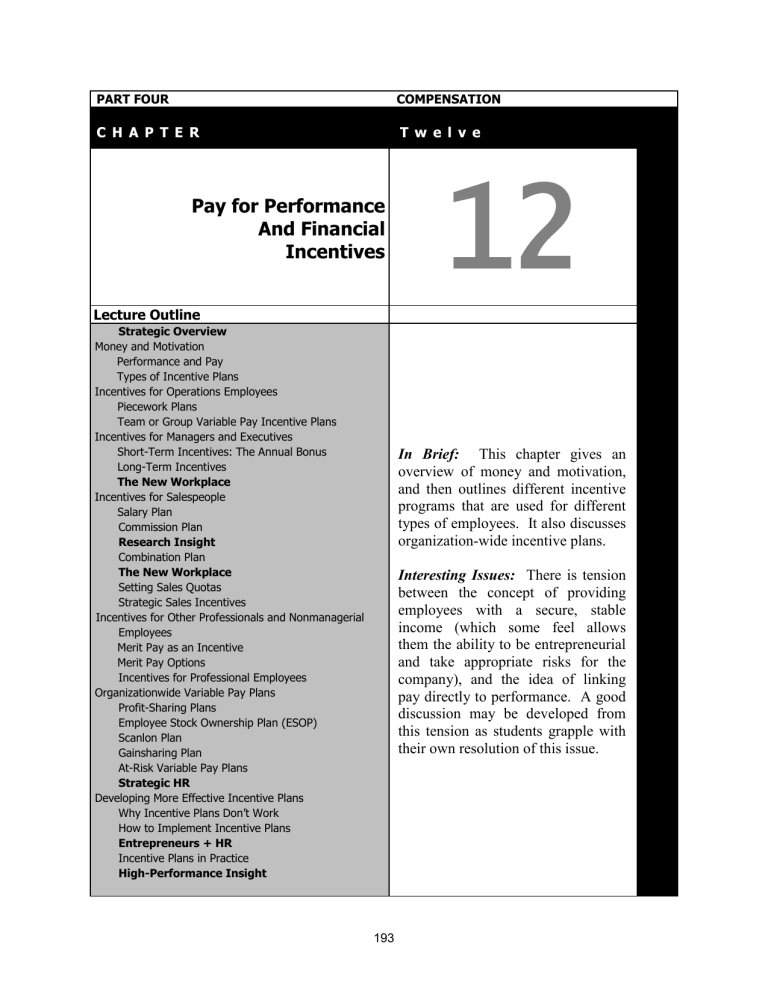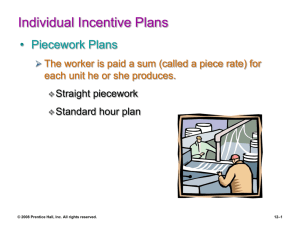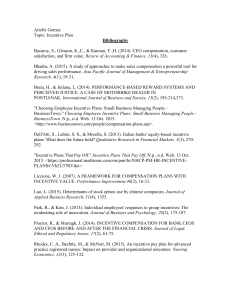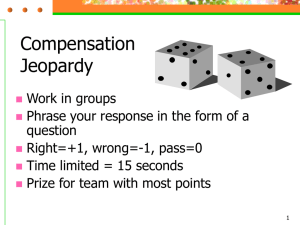LearnInMotion.com The Incentive Plan

PART FOUR COMPENSATION
C H A P T E R T T w e l v e
Pay for Performance
And Financial
Incentives
12
Lecture Outline
Strategic Overview
Money and Motivation
Performance and Pay
Types of Incentive Plans
Incentives for Operations Employees
Piecework Plans
Team or Group Variable Pay Incentive Plans
Incentives for Managers and Executives
Short-Term Incentives: The Annual Bonus
Long-Term Incentives
The New Workplace
Incentives for Salespeople
Salary Plan
Commission Plan
Research Insight
Combination Plan
The New Workplace
Setting Sales Quotas
Strategic Sales Incentives
Incentives for Other Professionals and Nonmanagerial
Employees
Merit Pay as an Incentive
Merit Pay Options
Incentives for Professional Employees
Organizationwide Variable Pay Plans
Profit-Sharing Plans
Employee Stock Ownership Plan (ESOP)
Scanlon Plan
Gainsharing Plan
At-Risk Variable Pay Plans
Strategic HR
Developing More Effective Incentive Plans
Why Incentive Plans Don’t Work
How to Implement Incentive Plans
Entrepreneurs + HR
Incentive Plans in Practice
High-Performance Insight
In Brief: This chapter gives an overview of money and motivation, and then outlines different incentive programs that are used for different types of employees. It also discusses organization-wide incentive plans.
Interesting Issues: There is tension between the concept of providing employees with a secure, stable income (which some feel allows them the ability to be entrepreneurial and take appropriate risks for the company), and the idea of linking pay directly to performance. A good discussion may be developed from this tension as students grapple with their own resolution of this issue.
193
ANNOTATED OUTLINE
I. Money and Motivation
A. Performance and Pay – Compensation, shareholder value, and turbulence are factors that characterize business today, and they have produced a renaissance for financial incentive/pay-for-performance plans.
II.
B. Types of Incentive Plans include: individual incentive programs; group incentive programs; and profit-sharing plans. Variable pay generally refers to a group incentive plan that ties pay to some measure of the firm’s (or facility’s) overall profitability.
Incentives for Operations Employees
A. Piecework Plans – Piecework is where you pay the worker a sum (piece rate) for each unit he/she produces. Straight piecework entails a strict proportionality between results and rewards regardless of output. With a standard hour plan, the worker gets a premium equal to the percent by which his/her performance exceeds the standard.
B. Team or Group Variable Pay Incentive Plans pay incentives to the team based on the team’s performance. There are three approaches: 1) members are paid based on one of three formulas – all members receive the pay (a) earned by the highest producer, (b) earned by the lowest producer, or (c) equal to the average pay earned by the group; 2) set a production standard based on the final output of the group as a whole; or 3) tie rewards to goals based on some overall standard of group performance.
NOTES Educational Materials to Use
III. Incentives for Managers and Executives
A. Short-Term Incentives: The Annual Bonus is aimed at motivating the short-term performance of managers and executives.
1. Eligibility usually includes both top and lower level managers.
2. Fund Size refers to the total amount of bonus money the firm makes available. A nondeductible formula is where they use a straight percentage
(usually of the company’s net income) to create the short-term incentive fund.
A deductible formula assumes that the fund should start to accumulate only after the firm has met a specified level of earnings.
3. Individual Awards is set for each eligible position, and the actual award reflects the person’s performance.
– Typically, a target bonus (as well as maximum amount)
B. Long-Term Incentives are used to inject a long-term perspective into their executives’ decisions.
12-17
12-18
12-19
12-20
12-21
12-1
12-2
12-3
12-4
12-5
12-6
12-7
12-8
12-9
12-10
12-11
12-12
12-13
12-14
12-15
12-16
194
1. Stock Options account for over half of executives’ compensation. A stock option is the right to purchase a specific number of shares of company stock at a specific price during a specific period of time; the executive thus hopes to profit by exercising his/her option to buy the shares in the future but at today’s price.
2. Different Stock Option Plans – More companies are implementing broadbased stock option plans in which the potential appreciation is relatively modest, but in which all or most employees can participate. Figure 12-1 illustrates four types of stock option plans, each generally aimed at satisfying different purposes.
3. Other Plans – Stock appreciation rights permit the recipient to exercise the stock option (by buying the stock) or to take any appreciation in the stock price in cash, stock, or some combination of these. A performance achievement plan awards shares of stock for the achievement of predetermined financial targets. A restricted stock plan is where shares are usually awarded without cost to the executive, but restricted from selling the stock for a specified time period.
4. Performance Plans are designed so that executives don’t prosper unless the company does; thus, payment is contingent on achievement of predetermined objectives.
5. Cash vs. Stock Options – Stock options may be the simplest and wisest route.
C. Strategy and Executive Compensation – Few HR practices have as profound or obvious an impact on strategic success as the company’s long-term incentives.
In creating the compensation package you should: 1) define the strategic context for the executive compensation program, including the internal and external issues that face the company, and the firm’s business objectives; 2) shape each component of the executive compensation package based on your strategic aims, and then group the components into a balanced plan that makes sense in terms of these aims; 3) create a stock option plan that gives the executive compensation package the special character it needs to meet the unique needs of the executives and the company, and its strategy; 4) check the executive compensation plan for compliance with all legal and regulatory requirements and for tax effectiveness; and 5) install a process for reviewing and evaluating the executive compensation plan whenever a major business change occurs.
NOTES Educational Materials to Use
IV. Incentives for Salespeople
A. Salary Plans are offered by some firms. Straight salary makes it simple to switch territories or to reassign salespeople, and it can foster loyalty among the sales staff. A disadvantage is that it can constrict sales and de-motivate potentially high-performing salespeople.
B. Commission Plans pay salespeople for results, and only for results; thus, they tend to attract high-performing sales people who see that effort clearly leads to
12-22
12-23
12-24
12-25
12-26
12-27
12-28
12-29
12-30
195
V. rewards. But it may cause them to neglect non-selling duties like servicing small accounts, cultivating dedicated customers, and pushing hard-to-sell items.
1. Research Insight – One study found that commission plans can influence turnover. Another study found that being extroverted didn’t always lead to higher sales; extroverts only sold more when rewards were contingent on performance.
C. Combination Plan – Most companies pay salespeople a combination of salary and commissions, usually with a sizable salary component. Combination plans give salespeople a floor to their earnings, and still provide an incentive for superior performance. But they can become complicated, and misunderstandings can result.
D. Setting Sales Quotas – Setting effective quotas is an art. In today’s fast-changing business scene, sales quotas must become more flexible than they have been in the past.
1. An Example: Auto Dealers – Compensation for car salespeople ranges from a high of 100 percent commission to a small base salary with commission accounting for most of total compensation.
E. Strategic Sales Incentives – Sales commissions remain popular, but employers increasingly link them to nonvolume-based measures.
NOTES Educational Materials to Use
Incentives for Other Professionals and Nonmanagerial Employees
A. Merit Pay As An Incentive – Merit pay or raise is any salary increase the firm awards to an employee based on his/her individual performance. It is different from a bonus in that it usually becomes part of the employee’s base salary, whereas a bonus is a one-time payment.
B. Merit Pay Options – Traditional merit pay plans have two basic characteristics: (1) merit increases are usually granted to employees at a designated time of the year in the form of a higher base salary, and (2) the merit raise is usually based exclusively on individual performance. Two new adaptations of merit pay plans are: (1) one awards merit raises in one lump sum once a year and (2) merit awards are tied to both individual and organizational performance (see Table 12-
2).
C. Incentives for Professional Employees – Professional employees are those whose work involves the application of learned knowledge to the solution of the employer’s problems, such as lawyers, doctors, economists, and engineers.
Making incentive pay decisions for professional employees can be challenging because they’re usually paid well anyway.
12-31
12-32
12-33
12-34
12-35
12-36
12-37
12-38
12-39
12-40
196
VI. Organizationwide Variable Pay Plans
A. ProfitSharing Plans involves employees receiving a share of the company’s annual profits. There are several types of profit-sharing plans: cash plans,
Lincoln Incentive system, and deferred profit-sharing plans.
B. Employee Stock Ownership Plans (ESOP) are company-wide plans in which a firm contributes shares of its own stock or cash to purchase the stock to a trust established to purchase shares of the firm’s stock for employees.
High-Performance Insight —Thermacore has been successful in recent years and management is convinced that at least part of the success is due to an employee bonus program and a stock ownership program. This paragraph gives some details of both program, but the interesting thing is that the bonus program gives the same dollar bonus to all employees, regardless of income, seniority, or position in the company.
C. Scanlon Plan is an incentive plan developed in 1937 by Joseph Scanlon. The basic features of the plan include: philosophy of cooperation, identity, competence, involvement system, and sharing of benefits formula.
D. Gainsharing Plans are incentive plans that engage many or all employees in a common effort to achieve a company’s productivity objectives, with any resulting cost-savings gains shared among employees and the company.
1. Implementing a Plan – The basic eight steps are: 1) establish general plan objectives; 2) define specific performance measures; 3) decide on a funding formula; 4) decide on a method for dividing and distributing the employees’ share of the gains; 5) make the disbursement significant enough to get participants’ attention and to motivate their behavior; 6) choose the form of payment; 7) decide how often bonuses are to be paid; and 8) develop the involvement system.
2. Making the Plan Work – Many firms use a “family of measures” to ensure their employees don’t ignore important activities. Some key ingredients for successful programs include: management involvement and commitment; a simple financial formula; employee involvement; and two-way communication between management and employees.
E. At-Risk Variable Pay Plans are plans that put s ome portion of the employee’s weekly pay at risk, subject to the firm meeting its financial goals.
1. Strategic HR – AmeriSteel’s HR-based incentive plan, called Partners in
Performance, helped it achieve its strategic aims of increasing productivity and being competitive.
NOTES Educational Materials to Use
12-41
12-42
12-43
12-44
12-45
12-46
12-47
12-48
197
VII. Developing More Effective Incentive Plans
A. Why Incentive Plans Don’t Work – Some explanations include: performance pay can’t replace good management; you get what you pay for; “pay is not a motivator;” rewards punish; rewards rupture relationships; rewards can unduly restrict performance; rewards may undermine responsiveness; rewards undermine intrinsic motivation; and people work for more than money.
B. How to Implement Incentive Plans – Some guidelines to follow to make your plan more effective: use common sense; link the incentive with your strategy; make sure effort and rewards are directly related; make the plan easy for employees to understand; set effective standards; view the standard as a contract with your employees; get employees’ support for the plan; use good measurement systems; emphasize long-term as well as short-term success; take the corporate culture into consideration; and adopt a comprehensive, commitment-oriented approach.
Entrepreneurs + HR —Outlines problems that the FLSA has created for companies that use incentive pay as a part of their employee regular pay. A major issue is that those incentive payments usually must be counted as part of the base pay when computing overtime pay. The discussion box gives an example to clarify this confusing issue.
C. Incentive Plans in Practice – Most companies have several incentive plans.
Figure 12-3 summarizes the percentage of companies using each of several selected plans.
High-Performance Insight —Outlines Federal Express' compensation plan. It lists seven different pay-for-performance programs that Fed Ex has as part of its plan. All programs, with the exception of the merit program, are paid in one-time, lump-sum awards.
NOTES Educational Materials to Use
KEY TERMS
fair day's work Frederick Taylor's observation that haphazard setting of piecework requirements and wages by supervisors was not sufficient, and that careful study was needed to define acceptable production quotas for each job. scientific management The careful, scientific study of the job for the purpose of boosting productivity and job satisfaction. variable pay Any plan that ties pay to productivity or profitability, usually as one-time lump payments.
12-49
12-50
12-51
12-52
12-53
12-54
12-55
12-56
198
piecework A system of pay based on the number of items processed by each individual worker in a unit of time, such as items per hour or items per day. straight piecework An incentive plan in which a person is paid a sum for each item he or she makes or sells, with a strict proportionality between results and rewards. standard hour plan A plan by which a worker is paid a basic hourly rate, but is paid an extra percentage of his or her base rate for production exceeding the standard per hour or per day. Similar to piecework payment, but based on a percent premium. team or group incentive plan
A plan in which a production standard is set for a specific work group, and its members are paid incentives if the group exceed the production standard. annual bonus Plans that are designed to motivate short-term performance of managers and are tied to company profitability. stock option The right to purchase a stated number of shares of a company stock at today's price at some time in the future. mega-option grants merit pay (merit raise)
Large, upfront grants in lieu of annual grants.
Any salary increase awarded to an employee based on his or her individual performance. profit-sharing plan employee stock ownership plan (ESOP)
A plan whereby most employees share in the company's profits.
A corporation contributes shares of its own stock to a trust in which additional contributions are made annually. The trust distributes the stock to employees on retirement or separation from service.
Scanlon plan An incentive plan developed in 1937 by Joseph Scanlon and designed to encourage cooperation, involvement, and sharing of benefits. gainsharing plan An incentive plan that engages employees in a common effort to achieve productivity objectives and share the gains. at-risk variable pay plans
DISCUSSION QUESTIONS
Plans that put some portion of the employees’ weekly pay at risk, subject to the firm meeting its financial goals.
1. Compare and contrast six types of incentive plans. Various types of incentive plans were presented in the text, including piecework plans, straight and guaranteed plans, standard hour plans, plans for salespersons (commissions and combination plans), and group incentive plans. With the piecework plans, earnings are tied directly to what the individual worker produces, and are more appropriate in a manufacturing organization. Commissions are more appropriate for salespeople in situations where they are largely unsupervised. In-group incentive plans like the Scanlon Plan, all workers involved in developing and implementing cost savings share in the benefits of the suggestions.
199
2. Explain five reasons why incentive plans fail.
When incentive plans fail, it can be for a variety of reasons like: employees do not believe that effort will obtain the reward, bad management overrides the plan, rewards tied to the wrong measures, plan is complicated and difficult for employees to understand, or standards are too high or too low.
3. Describe the nature of some important management incentives .
Two widely used management incentive plans are merit pay and profit sharing plans. Merit pay is any salary increase that is awarded to an employee on his or her individual performance. Advocates argue that only pay tied directly to performance can motivate improved performance. Profit sharing plans distribute a portion of the company's profits to employees in the form of a bonus. Research shows that benefits are more subtle than increased productivity —benefits are possibly in the form of better worker commitment.
There might also include long-term incentives.
4. When and why would you pay a salesperson a salary and commission combined?
Salary plans work well when your objective is prospecting work or where the salesperson is primarily involved in account servicing. They are often found in industries that sell technical products. A commission plan is appropriate when sales costs are proportional to sales. This can reduce the selling investment for fixed costs. The straight commission also provides salespeople with the greatest possible incentive and there is a tendency to attract high-performing people. Combination plans are used when the firm wants to direct its salespeople's activities by detailing what services the salary component is being paid for while the commission component provides a built-in incentive.
5. What is merit pay? Do you think it's a good idea to award employees merit raises? Why or why not?
Merit pay is a salary increase that is awarded to an employee based on his or her individual performance. It is a good idea to award merit raises when you have a good performance appraisal system and employees' individual effort can be fairly and accurately evaluated or measured.
6. In this chapter, we listed a number of reasons experts give for not instituting a pay-forperformance plan (such as "rewards punish"). Do you think these points (or any of them) are valid? Why or why not?
All of these reasons are, or can be, valid. There will also be organizational situations where one or more of them will not be valid. Students should describe situations in which the reason is (or is not) valid.
7. What is a Scanlon plan? Based on what you've read in this book so far, what features of a commitment-building program does the Scanlon plan include?
This is an incentive plan that was developed in 1937 by Joseph Scanlon. It includes features such as a philosophy of cooperation, identity, competence, involvement, and sharing of benefits. All these are features of a commitmentbuilding program. The Scanlon plan is actually an early version of what today is known as a gainsharing plan.
8. Give four examples of when you would suggest using team or group incentive programs rather than individual incentive programs.
Students should review the sections in the chapter on team or group incentive programs and individual incentive programs, and think about situations where they would prefer one incentive plan over the other.
DESSLER COMPANION WEB SITE
We invite you to visit the Dessler homepage ( http://www.prenhall.com/dessler ) on the
Prentice Hall Web site for the best online business support available. This site provides professors with a customized course Web site, including new communication tools, one-click navigation of chapter content, and great resources, such as Internet Resources, an HRCI Exam Prep Guide, assessment exercises, and more.
200
INDIVIDUAL AND GROUP ACTIVITIES
1. Working individually or in groups, develop an incentive plan for the following positions: chemical engineer, plant manager, used-car salesperson. What factors did you have to consider in reaching your conclusions? I would give the chemical engineer a merit raise system because he or she has little perceived control or impact over the production or profitability of the company. The plant manager should receive an annual bonus tied to the profitability of the plant, as well as a stock option plan to encourage long-term planning as well. The used-car salesperson would likely receive a straight commission plan because sales are more directly dependent on his or her ability to sell those cars to prospective customers.
2. A state university system in the southeast recently instituted a "Teacher Incentive Program"
(TIP) for its faculty. Basically, faculty committees within each university’s college were told to award $5,000 raises (not bonuses) to about 40% of their faculty members based on how good a job they did teaching undergraduates and how many they taught per year. What are the potential advantages and pitfalls of such an incentive program? How well do you think it was accepted by the faculty? Do you think it had the desired effect?
This program would put a premium on undergraduate teaching as opposed to research or graduate teaching. If it were to work, the best teachers would be motivated to teach at the undergraduate level in order to increase their earnings. The pitfalls are many. Some research or graduate faculty may actually make more through consulting or other outside means, thus they will not be motivated by this system. If research is important to this organization, or the graduate programs are vital, this incentive plan could damage those programs. The awarding of the moneys is likely to be inconsistent because specific guidelines have not been spelled out. More likely, the rewarding of the raises may become more political as the committees who have other values determine the awards. It is very likely that the system was met with great opposition by the faculty.
EXPERIENTIAL EXERCISES & CASES
Experiential Exercise: Develop a Compensation Plan
This exercise presents a fictional auto dealership and problems that they are experiencing with customer satisfaction and quality. Students are to analyze the current compensation system to see if it contributes to the problem.
1. In what ways migh t your group’s compensation plan contribute to the customer services problems?
Sales force : pay is based almost entirely on commission. The salesperson has no motivation to assist customers who they do not believe will result in a sale. Finance office : bonuses for getting customers to use the company financing encourage finance people to coerce people into making that choice. Detailing : pay is based entirely on the number of cars detailed per day. There is no measure of quality, nor requirement of it regarding pay. Mechanics : pay is based almost entirely on number of cars serviced as well as servicing them faster than the standard estimated repair time.
There is no measurement of quality or accuracy of repairs. Receptionist/phone service people : straight hourly rate does not have any performance rewards.
2. Would you recommend a team incentive plan within each of the five teams and a team incentive plan based on the overall customer service of Express Automotive? If so, how would you structure the two different team incentive plans.
The students may answer yes or no.
They need to base their responses on their understanding of the section on team or group incentive plans.
201
3. What recommendations would you make to improve the compensation system in a way that would likely improve customer satisfaction?
The dealership already has a customer satisfaction survey in place. They need to link results from quality measures to the incentives that their employees receive. Examples are: Sales force : one might decrease the commission somewhat and place that amount in a pool that is distributed based on customer comments about specific sales personnel. Finance office : bonuses for using company financing should be no more than bonuses based on customer satisfaction ratings. Detailing : there must be a measure of quality and detailers should be docked for any problem that results from their lack of attention to detail. Mechanics : reworks should dock a mechanics pay and mechanics whose work results in no complaints should receive a significant bonus. Receptionist/phone service people : those who answer the phone should be able to gain either performance increases in pay, or bonuses based on customer satisfaction ratings. In general, the approach sh ould be like “teaching to the test.” If you want test scores to improve, you teach what will be on the test. If you want measures of customer satisfaction to improve, you reward (or punish) people for those measures.
Case Application: Bringing the Team Concept into Compensation – Or Not
Sandy Caldwell, the new Human Resources Manager for Hathaway manufacturing, wanted to improve teamwork at every level of the organization. As part of the process of implementing cultural change,
Sandy introduced a new pay for performance system. The reaction to the change was immediate and
“100 % negative”.
1. Does the pay-for-performance plan seem like a good idea? Why or why not? Management wants to provide incentive for team performance. Their motives are fine. Properly crafted (and with employee involvement) a pay for performance system may add value at Hathaway.
2. What advice would you give Regina and Sandy as they consider their decision? Most scholars suggest that pay for performance works best (in the US), when it has both an individual and a team component. Further, Regina and Sandy need to consider ways of engaging the workforce in the design/decision process. This involvement will likely provide better ideas, identify potential problem areas with proposed systems before they are implemented and aid in the implementation process.
3. What mistakes did they make in adopting and communicating the new salary plan? How might
Sandy have approached this major compensation change a little differently? Sandy failed to involve significant stakeholders in the process. Their input would likely have identified potential weaknesses in her system. Further, by not involving others, the change in pay came largely as a surprise. Employees take their pay seriously; surprises are not welcome. Sandy already had agreement on some issues like the mission and the vision. She could have used that agreement to begin a dialog on linking compensation more directly to effectively accomplishing the mission.
4. Assuming the new pay plan was eventually accepted, how would you address the fact that in the new performance evaluation system, employees’ input affects their peers’ pay levels?
Typically, plans have two levels – a team component and an individual component. It is important for the team to realize that the company does best when the whole team succeeds, and that team success also requires individual performance.
Continuing Case: LearnInMotion.com The Incentive Plan
1. Up to this point we’ve awarded only a tiny fraction of the total stock options available for distribution. Should we give anyone or everyone additional options? Why or why not?
They should first find out from the employees if they perceive the stock options to be a desired incentive.
Based on what they find out from the employees, they should develop a stock option distribution plan based on their learnings from the chapter.
202
2. Should we put other employees on a pay-for-performance plan that somehow links their monthly or yearly pay to how well the company is doing sales-wise? Why or why not? If so, how should we do it?
Based on their knowledge of pay-for-performance plans, the students should consider how the other employees impact the company’s sales performance. The students should determine how they would structure a pay-for-performance plan for the other employees, and if it would be the same for each of the other employees.
3.
Is there another incentive plan you think would work better for the salespeople? What is it?
The students need to consider the various short-term and long-term incentive plans discussed in the chapter.
4. On the whole what do you think the sales problem is?
As Mel stated, the sales problem would be a combination of all of the problems mentioned in the case. The students should justify what they think the sales problem is.
203
CHAPTER 12 POWERPOINTS
204
205
206
207
208
209
210







